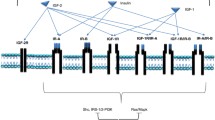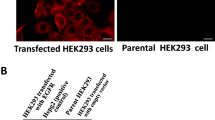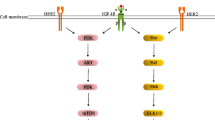Abstract
Many reports have indicated that the insulin receptor (IR) causes tumorigenesis and the development of breast cancer. It has been considered a potential target for treating IR-related tumors. Traditionally, there are two categories of insulin receptor (IR) antagonists, they are small molecule antagonists and anti-IR antibodies. Here, we describe a new method (anti-idiotypic antibody strategy) for the development of IR antagonist. Hybridoma technology was employed to design and identify a series of anti-idiotypic antibodies against insulin. After repeated screening and identification, an anti-idiotypic antibody against IR (AK98) was obtained. Analysis through competitive ELISA and competitive receptor binding indicated that AK98 mimicked the receptor binding epitope of insulin. The interaction between AK98 and IR was determined using indirect immunofluorescence, immunoelectron microscopy, and Immunoprecipitation-Western (IP-WB). Further research using a tumor cell model revealed that AK98 inhibited insulin-IR binding and IR-mediated intracellular signaling pathways. Conclusively, the main purpose of this paper is that we proposed a new method (anti-idiotypic antibody strategy) to develop the insulin receptor (IR) antagonist (AK98), and a series of experiments showed that the anti-idiotypic antibody (AK98) exhibited good antagonistic activity against IR. This work suggests that the anti-idiotypic antibody may be a potential strategy to develop IR antagonists that can be used in treating breast cancer.









Similar content being viewed by others
Abbreviations
- IR:
-
Insulin receptor
- IGFR:
-
Insulin-like growth factor
- AKT:
-
Protein kinase B
References
Lu M, Wan M, Leavens KF, Chu Q, Monks BR, Fernandez S, et al. Insulin regulates liver metabolism in vivo in the absence of hepatic Akt and Foxo1. Nat Med. 2012;18:388–94.
Plum L, Schubert M, Brüning JC. The role of insulin receptor signaling in the brain. Trends Endocrinol Metab. 2005;16:59–655.
Cohen P. The twentieth century struggle to decipher insulin signalling. Nat Rev Mol Cell Biol. 2006;7:867–73.
Belfiore A, Malaguarnera R. Insulin receptor and cancer. Endocr Relat Cancer. 2011;18:125–47.
Sachdev D, Singh R, Fujita-Yamaguchi Y, Yee D. Down-regulation of insulin receptor by antibodies against the type I insulin-like growth factor receptor: implications for anti-insulin-like growth factor therapy in breast cancer. Cancer Res. 2006;66:2391–402.
Haluska P, Carboni JM, Loegering DA, et al. In vitro and in vivo antitumor effects of the dual insulin-like growth factor-I/insulin receptor inhibitor, BMS-554417. Cancer Res. 2006;66:362–71.
Jerne NK. Towards a network theory of the immune system. Ann Immunol. 1974;125:373–5.
Jerne NK, Roland J, Cazenave PA. Recurrent idiotopes and internal images. EMBO J. 1982;1:2473–8.
Lan HN, Hong P, Li R, Zheng X. Internal image anti-idiotypic antibody: a new strategy for the development a new category of prolactin receptor (PRLR) antagonist. Mol Immunol. 2017;87:86–93.
Vigneri R, Goldfine ID, Frittitta L. Insulin, insulin receptors, and cancer. J Endocrinol Investig. 2016;39:1365–76.
Shechter Y, Maron R, Elias D, Cohen IR. Autoantibodies to insulin receptor spontaneously develop as anti-idiotypes in mice immunized with insulin. Science. 1982;216:542–5.
Shechter Y, Elias D, Maron R, Maron R, Cohen IR. Mice immunized to insulin develop antibody to the insulin receptor. J Cell Biochem. 1983;21:179–85.
Lan HN, Zheng X, Khan MA, Li S. Anti-idiotypic antibody: a new strategy for the development of a growth hormone receptor antagonist. Int J Biochem Cell B. 2015;68:101–8.
Acknowledgements
This work were supported by Shenzhen Science and Technology plan project (no. JCYJ20160428135756806), (no. JCYJ20160428141830465); National Natural Science Foundation of China (no. 81601382); Guangdong basic and Applied Basic Research Foundation (2020A1515010179).
Author information
Authors and Affiliations
Contributions
KWB, LXQ, DQC and ZXW: performed the experiments; KWB: drafted the manuscript; SFY and HDB: edited the manuscript; ZSJ: conceived of the study, and participated in its design and coordination.
Corresponding author
Ethics declarations
Conflict of interest
The authors declare that they have no conflicts of interest.
Ethical approval
This article does not contain any studies with human participants or animals performed by any of the authors.
Additional information
Publisher's Note
Springer Nature remains neutral with regard to jurisdictional claims in published maps and institutional affiliations.
Rights and permissions
About this article
Cite this article
Wenbin, K., Xiaoqin, L., Qiuchan, D. et al. Development of a novel insulin receptor (IR) antagonist that exhibits anti-breast tumor activity. Human Cell 33, 1204–1217 (2020). https://doi.org/10.1007/s13577-020-00381-3
Received:
Accepted:
Published:
Issue Date:
DOI: https://doi.org/10.1007/s13577-020-00381-3




